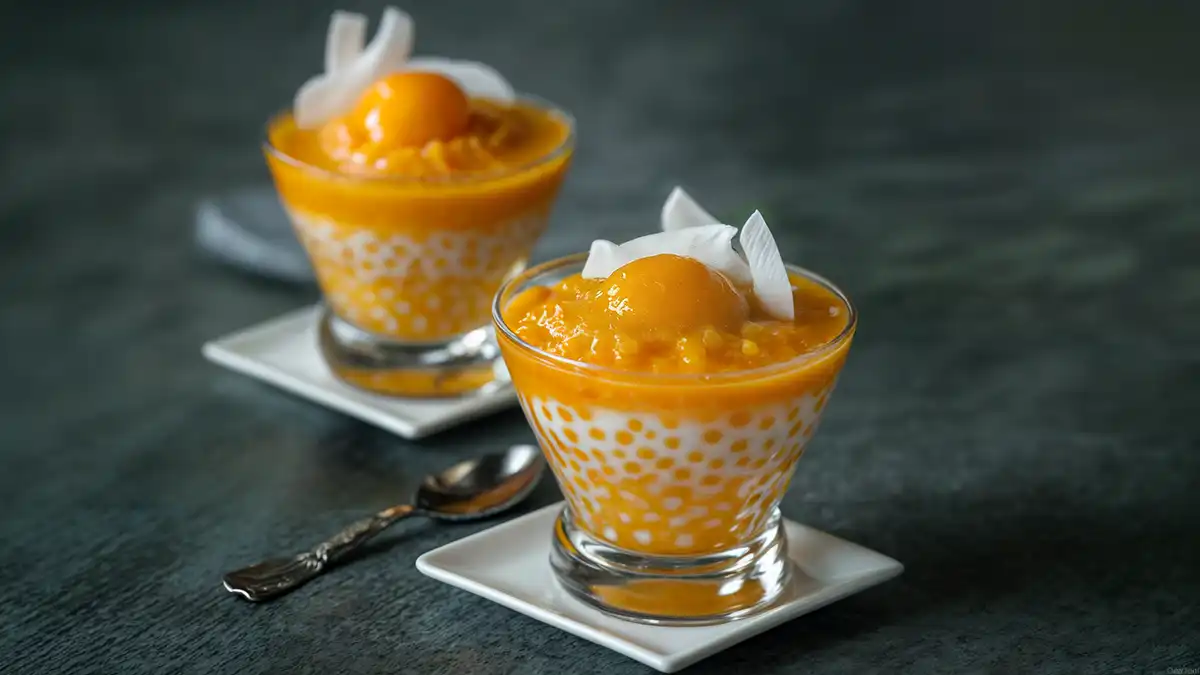Recipe for Mango Sago is a delightful treat that combines the tropical zest of ripe mangoes with the soft, chewy texture of sago pearls, enveloped in a creamy coconut milk base. This dessert not only captivates with its vibrant colors and sweet, tangy flavor but also offers a refreshing respite on any day. Let’s dive into the world of mango sago, where every spoonful is a summer escape!
Table of Contents
| Section | Content |
|---|---|
| Introduction | Overview of mango sago, its cultural significance, and introductory remarks on choosing the best mangoes. |
| Ingredients and Variations | Essential ingredients, creative variations, and tips for personalizing mango sago. |
| Step-by-Step Instructions | Detailed cooking steps for preparing sago pearls, blending mangoes, and combining ingredients for the perfect dessert. |
| Nutritional Value | Exploration of the health benefits of mangoes, nutritional content of mango sago, and tips for making healthier choices. |
| Storage and Serving Suggestions | Guidelines on storing and presenting mango sago to enhance both longevity and aesthetic appeal. |
| FAQs | Answers to common queries about mango sago including its origins, preparation tips, and ingredient details. |
Cultural Significance and Global Appeal
Originating from Southeast Asia, mango sago quickly became a beloved dessert across various cultures, praised for its simplicity and exotic appeal. This dish perfectly exemplifies how a few simple ingredients can transform into a culinary delight that transcends borders.
Why Mango Sago?
Why settle for a regular dessert when you can indulge in a bowl of mango sago? Its unique texture and flavor profile make it a standout dish that’s not only easy to prepare but also versatile enough to be customized to individual tastes.
Choosing the Perfect Mango: A Guide
Selecting the right type of mango is crucial for achieving the perfect balance of sweetness and texture in your mango sago. Here’s a quick guide to help you pick the best mangoes for this exquisite dessert:
Table: Top Mango Varieties for Mango Sago
| Mango Type | Characteristics | Why Suitable |
|---|---|---|
| Carabao | Sweet, creamy, and fiber-free | Enhances flavor without the texture of fibers |
| Ataulfo | Smooth texture, sweet and buttery | Melts in the mouth, perfect for blending |
| Alphonso | Rich, creamy, and highly aromatic | Adds a deep, tropical flavor to the dessert |
Each of these mango types brings something special to the table, making your mango sago not just a dish, but an experience.
Ingredients and Variations for Making Recipe for Mango Sago
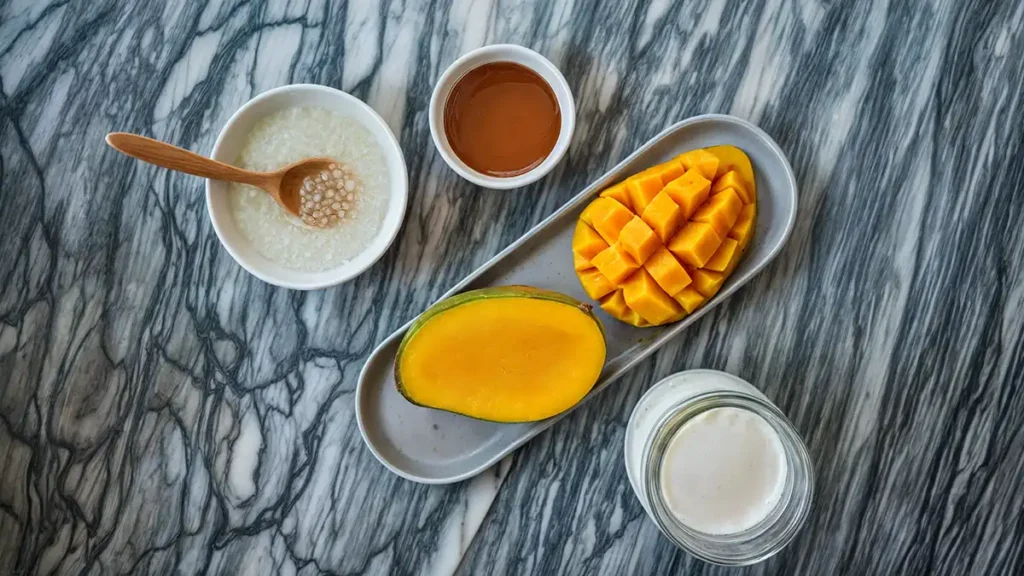
Crafting the perfect mango sago requires a harmonious blend of select ingredients and the freedom to tweak the recipe according to your taste. Here’s everything you need to know about choosing the right components and customizing the dish.
Essential Ingredients for Mango Sago
The beauty of mango sago lies in its simplicity. Here’s what you’ll need:
- Mangoes: The star of the show. Pick ripe, juicy mangoes that are naturally sweet.
- Sago Pearls: These tiny tapioca pearls add a delightful texture to the dessert.
- Coconut Milk: For that creamy, tropical flavor that binds everything together.
- Sweeteners: Common choices include sugar, honey, or condensed milk, depending on your preference for sweetness.
Creative Variations to Spice Up Your Mango Sago
Why stick to the basics when you can make your mango sago even more exciting? Consider these variations:
- Dairy Alternatives: Swap out traditional coconut milk with almond or soy milk for a different twist.
- Additional Fruits: Incorporate other fruits like papaya or pineapple for a multi-fruit sago that’s bursting with flavors.
- Herbal Notes: Add a hint of mint or basil for a refreshing aroma and a pop of green.
Switching up the ingredients can transform the taste and presentation of your mango sago, making it a personal signature dessert that’s perfect for any occasion.
Linking Culinary Worlds: Recipe for Mango Sago and International Desserts
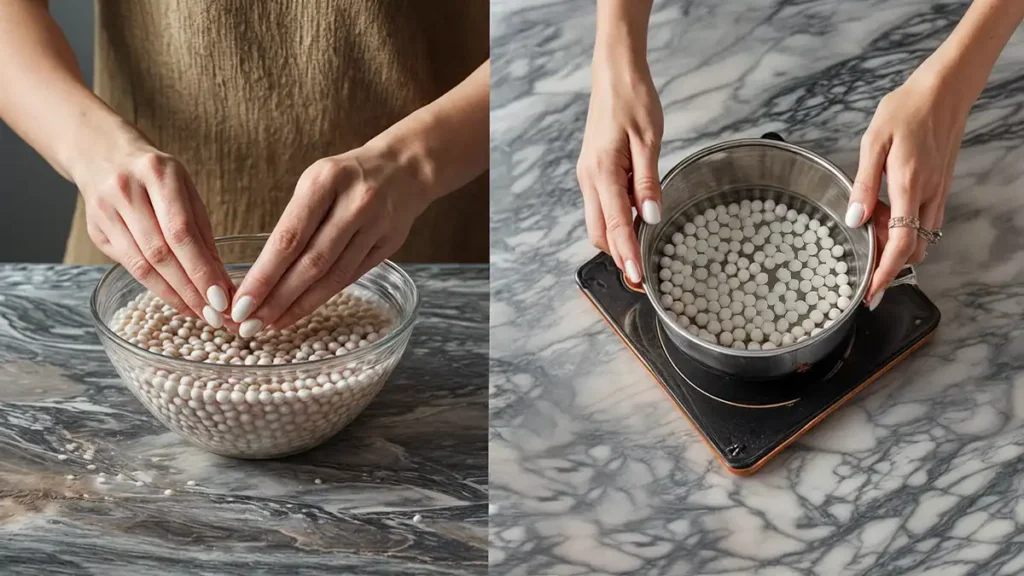
Just like our beloved mango sago, many desserts from around the world combine fruit with creamy textures. For those who enjoy exploring international cuisines, check out the Raspberry Chipotle Sauce. It’s another excellent example of how simple ingredients can create a profound taste experience, perfect for those who love a little kick with their sweet.
Tips for Perfect Mango Sago Every Time
Achieving the perfect mango sago is easy if you follow these tips:
- Sago Cooking: Make sure to boil the sago pearls until they are completely translucent. This ensures the right texture without any grittiness.
- Mango Prep: Blend the mangoes until smooth to get a creamy, luscious puree. For a more textured dessert, blend less.
- Chilling Time: Allow the mango sago to chill thoroughly before serving. This enhances the flavors and provides that refreshing coolness.
With these ingredients, variations, and tips, you’re all set to make a mango sago that will impress and refresh anyone who tries it.
Step-by-Step Instructions to Make Recipe for Mango Sago
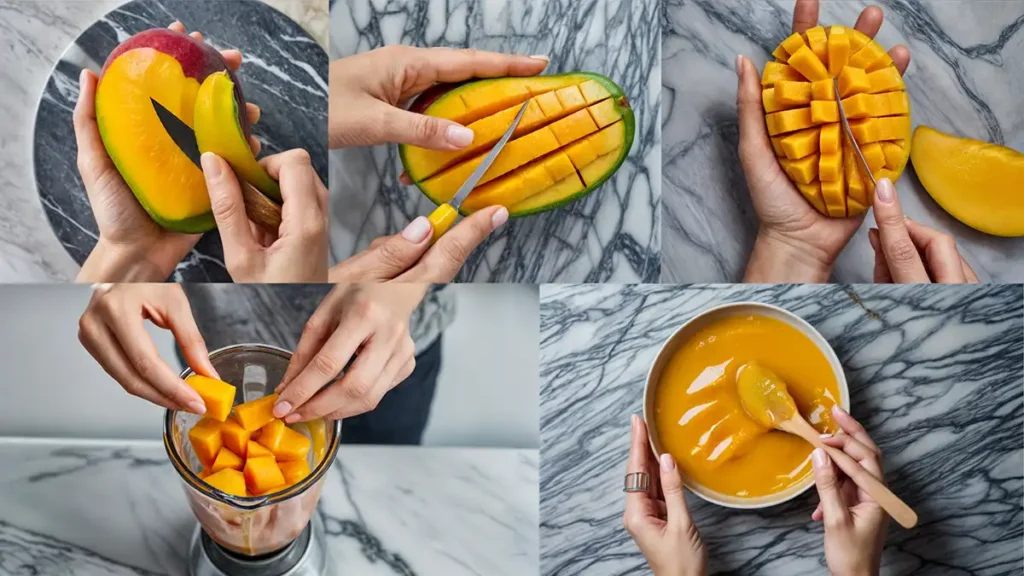
Creating mango sago is a fun culinary journey that’s both simple and rewarding. Let’s break down the process into detailed steps to ensure you nail it every time!
Preparing the Sago Pearls
- Boil the Water: Start by boiling a large pot of water. You need enough water to give the sago pearls plenty of room to expand without sticking.
- Cook the Sago: Add the sago pearls to the boiling water. Stir continuously to prevent them from sticking to the bottom.
- Check the Doneness: Cook until the pearls turn translucent. This usually takes about 10-15 minutes. Be patient; it’s the key to perfect sago pearls!
- Cool and Rinse: Drain the sago in a colander and rinse under cold water to stop the cooking process and remove excess starch.
Blending the Mangoes
- Select and Peel the Mangoes: Choose ripe mangoes that are soft to the touch. Peel them and remove the pit.
- Blend to Perfection: Place the mango flesh in a blender. Blend until smooth to create a rich, velvety mango puree. For a thicker texture, blend less.
Combining Ingredients
- Mix Mango and Sago: In a large bowl, combine the chilled sago pearls with the mango puree.
- Add Coconut Milk: Pour in coconut milk to achieve a creamy consistency. Mix well.
- Sweeten to Taste: Add sugar or condensed milk, adjusting according to your sweetness preference.
Chilling and Serving
- Refrigerate: Chill the mixture in the fridge for at least an hour to allow the flavors to meld together beautifully.
- Serve and Enjoy: Serve the chilled mango sago in bowls. You can garnish with fresh mango pieces or a sprig of mint for that extra touch.
For those looking to explore more unique dessert recipes that blend fruits and creamy textures, consider the Cinnamon Applesauce Recipe. It’s a simple yet delicious treat that pairs wonderfully with various desserts, adding a sweet and spicy flair to traditional recipes.
Watch a Recipe for Mango Sago Tutorial Video
To help you visualize the process and follow along easily, here’s a helpful tutorial video on making mango sago:
Follow these steps and tips to create a delightful mango sago that’s perfect for any occasion, from casual gatherings to special celebrations.
Nutritional Value of Recipe for Mango Sago
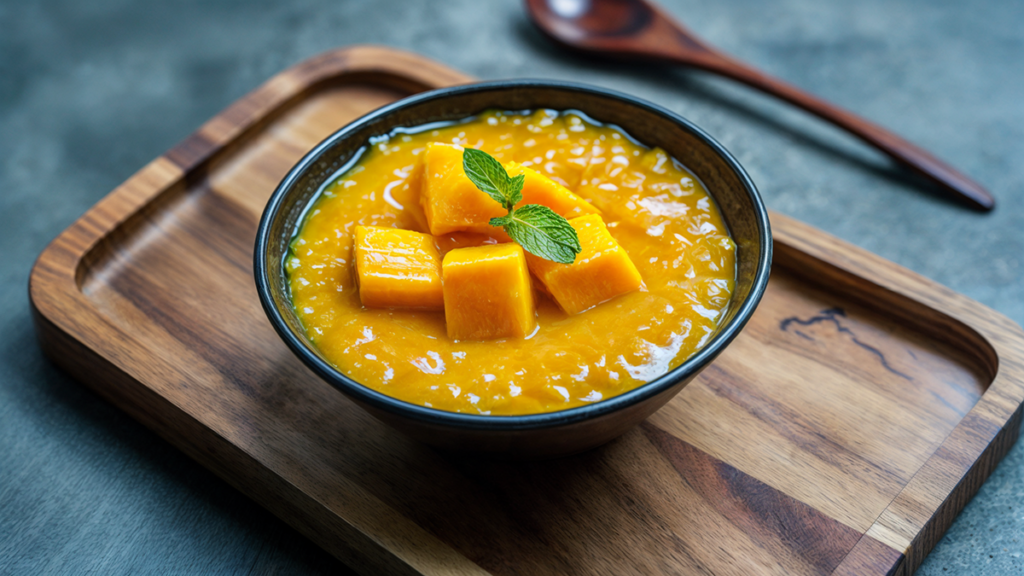
Delving into the nutritional aspects of mango sago not only helps us appreciate its delicious taste but also understand the health benefits it offers. Let’s explore how this delightful dessert can be part of a balanced diet.
Health Benefits of Mango
Mango, often referred to as the “king of fruits,” is not only delicious but also packed with nutrients:
- Vitamins: Mangoes are a rich source of Vitamin C, which aids immunity, and Vitamin A, important for vision and skin health.
- Dietary Fiber: Helps in digestion and can aid in weight management.
- Antioxidants: Contains antioxidants like zeaxanthin and beta-carotene that help protect the body against free radicals.
Eating mangoes can be a tasty way to incorporate more nutrients into your diet.
Calories and Nutritional Breakdown
Mango sago is a relatively low-calorie dessert, especially when compared to other creamy desserts. Here’s a quick look at its nutritional content per serving:
| Nutrient | Amount |
|---|---|
| Calories | 200-300 kcal |
| Carbohydrates | 50-70 g |
| Protein | 2-3 g |
| Fat | 5-10 g |
| Dietary Fiber | 3-5 g |
| Sugars | 30-40 g |
This dessert can be a good option if you’re looking for something sweet that isn’t too heavy.
Making Mango Sago a Healthier Choice
To make mango sago an even healthier choice, consider the following tips:
- Reduce Sugar: Use less sugar or substitute with natural sweeteners like honey to lower the calorie count.
- Opt for Low-Fat Coconut Milk: This can significantly reduce the fat content without compromising the creamy texture.
- Add More Fruits: Incorporate other fruits to increase the fiber content and enhance the nutritional value.
If you’re exploring ways to enjoy mangoes in other healthy recipes, be sure to check out our Purple Sweet Potato Recipes. These recipes are not only nutritious but also bring a vibrant color and unique taste to your table.
Incorporating Mango Sago Into Your Diet
Mango sago can be a delightful addition to your diet, especially if you’re looking for something light and refreshing. Explore this detailed source for more information on the nutritional benefits of mango.
Storage and Serving Suggestions for Mango Sago
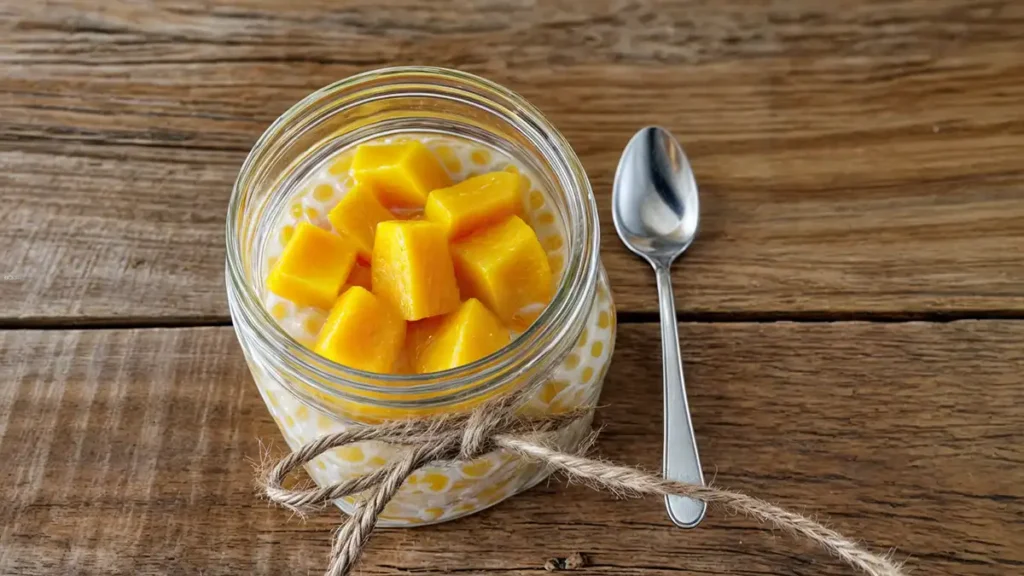
Proper storage and elegant serving can elevate mango sago from a simple dessert to a showstopper at your gatherings. Here’s how to keep it fresh and present it beautifully.
Best Practices for Storing Mango Sago
To ensure your mango sago stays delicious and safe to eat, follow these storage tips:
- Refrigeration: Always store mango sago in the refrigerator. It should be kept in an airtight container to maintain freshness and prevent it from absorbing other flavors from the fridge.
- Duration: Properly stored, mango sago can be enjoyed for up to three days after preparation.
- Freezing: For longer storage, mango sago can be frozen in an airtight container. Thaw in the refrigerator a day before you plan to serve it.
Serving Mango Sago for Different Occasions
Mango sago can be dressed up or down depending on the occasion:
- Casual Gatherings: Serve in clear bowls to showcase the vibrant color, topped with a mint leaf for a touch of green.
- Special Events: Enhance the elegance by serving in martini glasses, layered with different fruits for a festive look.
- Kids’ Parties: Use colorful cups and top with fun-shaped fruit slices to make it appealing to children.
Variations in Serving for Dietary Preferences
Catering to different dietary needs is important. Here are a few simple adjustments:
- Vegan Version: Use agave syrup instead of honey and ensure the coconut milk is certified vegan.
- Low-Sugar Version: Reduce the sugar or use a sugar substitute to cater to those watching their sugar intake.
- Gluten-Free: Mango sago is naturally gluten-free, making it a safe choice for those with gluten sensitivities.
For more serving ideas and tips on how to make your dishes stand out at any event, be sure to check out Grandma’s Old-Fashioned Salmon Patties Recipe. This recipe not only delivers on taste but also dives into the nuances of presenting traditional dishes in modern ways.
FAQs About Recipe for Mango Sago
What country is Mango Sago from?
Mango sago originated in Hong Kong and quickly became a popular dessert across Southeast Asia. It blends the rich, tropical flavor of mangoes with the unique texture of sago pearls, often enhanced with the creamy addition of coconut milk.
How long to cook sago for?
Cooking sago pearls perfectly requires a bit of patience. You’ll want to boil them for about 10 to 15 minutes until they become translucent. Make sure to stir continuously to prevent sticking and ensure even cooking.
Is sago the same as tapioca?
While sago and tapioca pearls look similar and are used interchangeably in recipes, they come from different sources. Sago is made from the starch of tropical palm trees, while tapioca is derived from the cassava root. Both provide a delightful chewy texture to dishes like mango sago.
What is mango tapioca made of?
Mango tapioca, often called mango sago, is a dessert made from a simple blend of mango puree, cooked tapioca (or sago) pearls, and coconut milk. Some variations might include additional sweeteners like sugar or condensed milk to enhance the flavor.
Conclusion
That wraps up our mango sago exploration! Whether you’re a long-time fan or new to this delightful dessert, I hope these tips and insights help you enjoy it even more. Got more questions or a cool variation to share? Drop a comment below – I’d love to hear how your mango sago turned out. Thanks for reading, and happy cooking!

